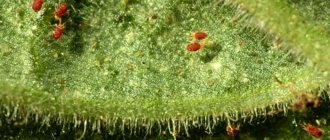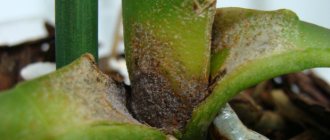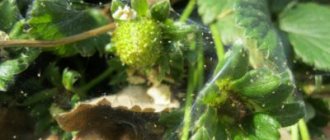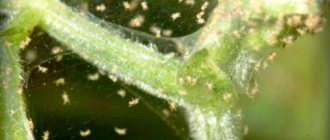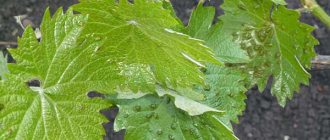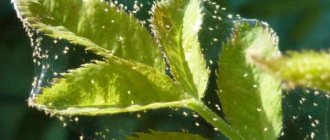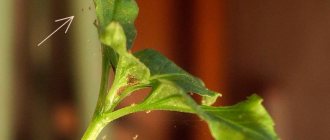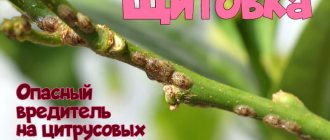It is not so easy to detect a spider mite on a lemon: it settles on the underside of the leaf, the size of an adult individual is no more than 1-2 mm.
As a rule, the appearance of a spider mite is suggested by the yellowing, drying out and falling of leaves for no apparent reason; you can notice lightened areas along the veins - these are the results of punctures that the mites make while feeding on the sap of the plant. There may also be cobwebs on the back of the curled leaves. It is in it that new generations of ticks are hatched. The parasite itself can be seen through a magnifying glass.
Spider mite, description and photo
Spider mites are arachnid insects ranging in size from 0.3 to 0.6 mm, depending on gender and fatness. Has 6 or 8 legs. Homemade lemons are most often inhabited by red insects and their dark green larvae. They move very slowly, most often live on the back side of the leaf blade, but sometimes they can be found on the outside. To the naked eye they can be identified as small red dots.
Spider mite on the back of the leaf, barely visible to the naked eye
They feed by piercing the leaf and drinking the juice of the plant; small yellow spots form in these places. Over the course of several months, 10-15 generations can develop, which will lay a large number of eggs, up to 200 per female. If the environment becomes unfavorable for them, then they find refuge - any crack or just soil in a pot, where in a state of diapause, that is, hibernation with a slowdown in processes in the body, they experience this period. And when they wake up, they go back to the old ways - actively drink lemon juice and multiply.
When there are already a large number of spider mites on the lemon, a web may appear
This pest loves dry and warm environments and is especially active in such conditions. First of all, it settles on young leaves, since it is easier to get to the juice on them, and then it occupies the entire plant.
To clearly understand that the lemon is sick with spider mites, you should take a sheet of white paper, place it under the crown and shake the plant. A number of insects will definitely fall on the leaf, and with the help of a magnifying glass they can be identified.
Yellow dots on a lemon leaf from spider mite bites
Folk remedies
It is advisable to fight spider mites with “grandmother’s” means only if the pests have not yet proliferated greatly, otherwise the use of methods is ineffective.
Spraying
Most often, infusions, herbal decoctions and solutions made from products harmful to parasites are used in the fight against spider mites. The composition is poured into a container with a spray bottle and used for generous spraying of infected flowers. The procedure must be repeated every three to five days until the pests disappear. Five or more sessions are usually required.
To prepare the infusion, the raw materials are poured with boiling water, settled and filtered. The table below will tell you what and how to prepare the product.
Table - Infusions for processing flowers
| Ingredient | Concentration per 1 liter of boiling water | Infusion time (in hours) |
| Finely chopped onion | 1 onion | 4-5 |
| Onion peel | 6 g | 3-5 |
| Shredded potato tops | 100 g | 3-4 |
| Chopped stems and leaves of celandine (dry or fresh) | 2 tablespoons | 4-5 |
| Dandelion roots and leaves | 3 tablespoons | 3-7 |
| Capsicum | 50 g | 3-4 |
| Ground horse sorrel root | 50-60 g | 3-4 |
Herbal infusions are also used in the fight against ticks, although their preparation is more labor-intensive. Two remedies are most effective.
- From dry grass and yarrow flowers. Pour a liter of boiling water over 100 g of raw material, boil for three minutes, leave for three to four hours, filter.
- From the roots of cyclamen. Cut several tubers into cubes, pour boiling water over them, cook for 40 minutes, cool, filter.
You can also treat with solutions from the following table.
Table - Solutions for processing flowers
| Ingredient | Concentration per 1 liter of water |
| Ground sulfur-tar soap | 10 g |
| Hydrogen peroxide, 3% | 2 tablespoons |
| Potassium permangantsovka | 2-4 crystals |
| Pine extract | 8-10 g |
Another composition for spraying: pour wood ash with boiling water in a ratio of 1:10, leave for a day and dilute with water, maintaining a ratio of 1:2, add crushed laundry soap (4 g per liter).
Ash can harm flowers that prefer acidic soil: azaleas, camellias, heathers, rhododendrons.
Rubbing
This method is more time-consuming than spraying, but it allows you to remove a certain number of mites from the affected plant. The therapy is carried out in three steps.
- Preparation. Moisten a cotton pad or soft cloth with the prepared product.
- Treatment. Wipe the leaves and stems, rinsing the cloth frequently in the mixture.
- Repetition. Do the treatment every three to five days until the pests disappear completely.
The following products are used for wiping:
medical alcohol - in its pure form, applied in a thin layer so that the plant does not get burned (suitable only for hard-leaved plants: orchids, hibiscus, dieffenbachia, date palm); ammonia - 3 ml of the drug per 1 liter of water; rosemary essential oil - two to four drops per 1 liter of water; vodka - diluted with water in a ratio of 1:2.
Hot shower
The development of spider mites stops at temperatures above 40 °C: jets of hot water can wash off the pests from the leaves of the plant. The procedure is carried out in three steps.
- Preparation. Protect the pot with earthen substrate with a plastic bag so that hot water does not damage the roots.
- Temperature selection. Ideally, the water temperature should be approximately 44-47°C; for ficus benjamina, hibiscus or monstera, this figure can be increased to 52°C.
- Treatment. Wash the stems and leaves of the flower on both sides. Processing time is no more than three to four minutes.
First, you need to do three procedures with an interval of three to four days, then repeat the session once a week for a month, and then once a month for prevention.
A hot shower should not be used to treat indoor flowers with tender and drooping leaves. For example, violets.
Products for “delicate” plants
What to do if the plant cannot be sprayed, wiped or placed under running hot water (for example, succulents)? Resourceful gardeners advise using one of two methods.
- "Fragrant" greenhouse. Place a container with a product whose fumes are harmful to pests next to the pot, cover with a plastic bag, and leave for several hours. Finely chopped garlic or turpentine can be used as a “flavoring”.
- Home steam room. Transfer the plant to the bathroom, close the door, and turn on a hot shower, setting the water temperature to maximum. After eight minutes, when the room is filled with warm steam, you need to time it for 10-15 minutes and leave the flower in the bathroom for this time.
How dangerous are spider mites for indoor lemons?
Pests make punctures on the leaves and suck out tissue fluid. This leads to a deficiency of nutrients. The plant withers as it quickly loses its liquid. As a result, the leaves fall off. But this process on lemon does not develop as rapidly as when small garden crops with soft leaves are affected.
The green mass of a houseplant differs in properties. The leaves are hard and large. The lemon reaches a significant height. This helps delay the death of the plant for a longer period.
If indoor lemon
periodically bears fruit, then in case of damage by spider mites, irregularly shaped ovaries are formed. They are smaller.
Diseases of citrus fruits in open ground, earthworms and slugs
As a result of changing climatic conditions, in some regions it is possible to grow citrus fruits in open ground.
However, even in this case, it is recommended to select frost-resistant varieties for planting and take care to prevent common fungal diseases, which include those listed in the table.
| Root rot | The disease affects the root areas, loosening the structure of the stem and the upper part of the roots. Develops as a result of high humidity and lack of heat. To save it, it is recommended to constantly clean the affected area from damaged parts, shorten the branches by two-thirds and minimize the frequency and amount of watering. Ideally, it is worth transplanting it to a new place |
| Melanosis | It can be identified by the formation of deep longitudinal cracks on branches or leaves, from which an amber-colored liquid later begins to ooze. When it hardens, it becomes like glass, and when exposed to moisture, it becomes like jelly. Young plants, not yet protected by strong bark, especially often suffer from pathology. Develops as a result of a large amount of moisture and lack of heat |
| Mycospherellosis | It manifests itself as swelling on the leaves, which gradually transform into oily blisters, followed by complete fall of the foliage. To prevent the development of the problem, it is recommended to periodically remove fallen leaves, in which a large number of pathogenic microorganisms accumulate. |
| Mold plaque | As a consequence, plant damage by parasites develops and is manifested by blackening of the leaves. The best treatment for the disease is to prevent parasite attacks |
However, it is not only diseases that can make life difficult for citrus fruits.
A fairly common problem for garden plants is slug attacks. These pests are dangerous because they gnaw leaves and damage branches.
Since slugs prefer to hide in damp fallen leaves, it is recommended to periodically remove them from under bushes so as not to provoke pest attacks.
Another common problem is earthworms. They are not pests, but their excessive numbers lead to inhibition of bush growth. There is no need to poison them; just water the soil with mustard solution (a teaspoon per liter of water). The worms will crawl out, after which it is enough to collect them and move them to another area.
Fighting various types of ticks
There are several varieties of mites that damage plants. You should know that all of them are not insects, they belong to the order of spiders, so remedies against the former may not work. The common spider mite most often lives on indoor plants - this pest is omnivorous, affecting both citrus fruits and roses, dracaenas, fuchsias, and palm trees.
On citrus fruits there is also the Atlantic spider mite, which, in addition to lemons and tangerines, loves palm trees, and the red spider mite, which settles on callas, orchids and nightshades. The latter variety is very prolific, and the higher the air temperature, the more actively it lays eggs. In the cold it hardly reproduces. Can't stand cold showers. The Atlantic pest is characterized by increased resistance and is very tenacious even in high humidity, which other varieties do not like.
In addition to them, you can find the cactus flat mite or the red flat mite. These varieties are almost insensitive to treating the plant with a soap solution, although this reduces their population size. Parasites are destroyed using:
- insecticides;
- irradiating the plant with a UV lamp;
- pyrethrum infusion (2-3 g per 1 liter of water).
Reproduction of ticks
Several generations live in the web they create. Ticks multiply at tremendous speed. Fertile females lay many round eggs. At first they are almost transparent, but after a while they become yellowish cloudy. The rate of embryo development depends on temperature. At +15 degrees - 15 days, at +30 - only two to three days! The full cycle occurs: from 30 to 36 days, if conditions are unfavorable, from 7 to 8, if conditions are good.
It becomes clear that the fight against spider mites on indoor plants should begin as early as possible. At low temperatures and high humidity, the larvae slow down their development. As conditions improve, mass infection occurs. Considering that spider mites quickly move to healthy plants, you need to know how to get rid of the mite in order to prevent the mass death of green pets. What harm do spider mites cause? When damaged, the plant becomes weak.
Signs of plant damage:
- the underside of the leaves is strewn with small dots;
- the entire plant or individual parts are intertwined with cobwebs;
- in case of severe damage, swarming pests can be seen in the web.
Spider mites carry:
- viral infections;
- gray rot spores.
Spider mite, methods of infection - where did it come from on plants at home?
It can get onto your house plants from the street through an open window, or it can come along with a bouquet of gifted roses. Mite eggs can remain in the soil for a long time and then become active. You can bring this pest home on your clothes. This is a very small and very common insect, you should always be on the lookout and check the lemon leaves for its presence. A few individuals will not cause much harm, but if the moment is missed, an outbreak of reproduction may occur, which will lead to serious damage to the plant by this pest.
Spider mite eggs are very small, sticky transparent balls.
Just like other pests, spider mites can be carriers of plant viruses . If you notice them, measures should be taken immediately.
Dangerous pests of citrus crops: introduction and control methods
Creating an exotic garden at home is truly a rewarding endeavor. However, pests of citrus plants that are invisible at first glance can gradually destroy them. To protect plantings from unexpected guests, it is best to get to know them better. It wouldn’t hurt to find a reliable weapon against them, and then use it in practice. Only then is there a chance to get rid of insect attacks forever and enjoy exotic fruits.
Photos of affected leaves and fruits
If you suspect that there are spider mites on a lemon, it is recommended to carefully examine the plant. Light dots are visible. They are easy to spot on top of the dark green leaves. Then darker spots (brown, yellow) appear. They unite into large pigmented areas, the leaves are deformed. At the same time, a thin cobweb is visible between them and the trunk. You can see a photo of what a mite looks like on a lemon and what the threat is when living on this plant.
Affected lemon leaves
What plants does the pest attack?
Among vegetables, spider mites often attack cucumbers, tomatoes, eggplants, peppers, legumes, and pumpkin crops .
Strawberries, gooseberries, currants, raspberries, and grapes are damaged by insects .
Spider mites harm fruit trees: apple trees, pears, apricots, cherries, plums, cherry plums .
The parasite loves flowers and ornamental plants: roses, asters, palm trees, fuchsias, callas, citrus fruits, orchids, impatiens, abutilons, ficuses, saintpaulias, cyclamen, pelargoniums, azaleas .
How to get rid of spider mites on house plants
Methods for controlling spider mitesIf a large number of pests have already accumulated on the leaves, you should start with their physical elimination. To do this, we put a bag over the plant’s pot and wash the crown of the plant under running warm water, about 50 degrees, with laundry soap. This will remove a significant number of pests.
If there are a large number of pests on the plant, it should be washed with soapy water.
The most effective way against spider mites is the use of chemicals. But this pest can also develop immunity to them, so they need to be changed periodically and new ones found if the old ones become ineffective. We use the following drugs at home.
Fitoverm
This drug can be called chemical conditionally, because it is created on the basis of substances formed by microorganisms living in the soil and, in its essence, is a natural substance. One of the safest drugs. After its use, after 16-10 hours, the spider mite loses the ability to eat food and dies after 2-3 days. The preparation itself on the foliage retains its properties for up to 7 days. To completely destroy pests, treatment should be carried out 4 times with a period of 6-9 days. It should be borne in mind that the effectiveness of this product decreases if the temperature is below 18 degrees. The working mixture is not stored. Dilute according to the instructions and spray evenly onto the crown of the plant. One of the features of this product is that it has a very unpleasant smell.
Created on the basis of substances formed by microorganisms
Aktellik
A good remedy that will help defeat not only spider mites, but also aphids, scale insects and others. Insects die upon contact with the substance and from inhaling its vapors. Diluted according to the instructions, approximately 1 ml. products for 1 liter of water. Open ampoules and solution should not be stored. Processing should be carried out in a room without animals and children. The treatment should also be repeated at least 3 times every 1 week.
Effective not only against spider mites, but also against aphids, scale insects and others
Demitan
One of the most effective remedies against spider mites on homemade lemons. It acts by contact - insects die when they touch the surface of the plant treated with this drug. Long period of action: 45-60 days. The drug is toxic to fish and should be used with extreme caution if you have an aquarium. You should not treat plants with this drug several times in a row; it becomes addictive to the spider mite and stops working. Repeated treatments should be carried out with other drugs.
One of the most effective remedies against spider mites on homemade lemons
Fighting spider mites requires a lot of patience , because the eggs they lay are resistant to chemical control agents and after the destruction of the main population, new individuals may soon appear. To avoid this, several treatments are required with a period between them of 7 to 10 days. So that new larvae hatch, but do not yet have time to reach maturity and lay eggs. Also, insects can develop resistance to drugs; they should be changed and new active ingredients should be looked for if the usual ones do not work.
Various drugs
There are general rules for all drugs:
- It is advisable to carry out the treatment in the fresh air, if this is not possible, in a very well-ventilated area.
- Use gloves. If necessary, use a mask. The recommendation for personal protective equipment is on the packaging of all drugs, but not all gardeners follow them.
- Clothes after treatment should be washed; surfaces on which the product may have come into contact should be washed thoroughly.
- Under no circumstances should it be disposed of in the apartment.
- Most products are contact, that is, pests die when they come into contact with the drug. Conclusion: you need to carefully treat the surfaces.
About the tools themselves:
- Actellik is a very powerful “killer” agent that will reliably get rid of ticks on a lemon. Acts on arachnids. It is recommended if plants are heavily and extensively affected by mites. The drug is extremely toxic, with a pungent odor.
- Neoron is a universal substance that can destroy both adults and eggs. One procedure, of course, is not enough, but two, as a rule, are enough to completely get rid of pests.
- Fitoverm is a fairly well-known drug because it is less toxic than others. It is perfectly acceptable (though not advisable) to spray it on plants in the bathroom. Affected lemons are treated with Fitoverm 3-4 times, at intervals of a week.
- Sunmite is similar in action to Neoron. The Japanese drug in powder form is very effective against ticks at any stage of development, but it is used on one plant no more than once a year, otherwise the ticks get used to it. Disadvantage: rarely found on sale.
- Aktofit is used mainly by greenhouses for treating open ground plants, but can also be used for indoor plants. The tick will require 1-2 treatments, at the rate of 4 ml of the drug per 1 liter of liquid.
- Aktara - the drug is not claimed to act against spider mites, it is an insecticide, it works against insects. However, in practice, many note that Aktara is really effective: after spilling a clod of earth with an affected tree, the mites disappear.
- Nissoran is a drug in powder form. Effective on all stages of ticks, except adult ones. That is, it will get rid of eggs, larvae, and nymphs of spider mites. It has a long-lasting effect (up to 1.5 months) and is non-phytotoxic. It is effective to use before there are too many adults. The result will be noticeable after 10 days (this is the period during which adult pests die of natural causes).
- Akarin is a drug in ampoules, characterized by a high speed of action, it affects ticks after 8-16 hours (on gnawing pests - after 4 hours).
- Apollo is a liquid drug that is rarely found on sale. However, it is popular among advanced gardeners in the fight against mites, because it is designed to protect the plant specifically from them and is able to act on eggs and larvae. The drug does not affect adult individuals, however, depriving them of the opportunity to reproduce (remember that the lifespan of a spider mite is from 30 hours to 8 days), quickly leads to the complete death of the parasites. The drug does not act once, but over a prolonged period; as a rule, 1-2 treatments are sufficient.
- Vermitek - dissolve 2.5-3 ml in 10 liters of water. Spray the plant, then wrap it in polyethylene and remove it after a day. The drug penetrates the flower tissue, thereby ensuring activity even after treatment.
- Agravertine - used against spider mites and many pests of open ground, for example, the Colorado potato beetle. Unlike most of the listed drugs, which act on the digestion of pests, it attacks their nervous system, causing paralysis. The parasites stop moving 6 hours after treatment and die within 2-3 days. To treat indoor lemons, dilute 5 ml per 1 liter of water.
Very poisonous drugs include those containing carbosulfan; it is better not to use them (Marshal drug).
Preparations in powder form do not always “stick” to plants well, so you can first spray the affected areas with stimulants (it is advisable to combine them with acaricides, that is, the above drugs), for example Epin or Zircon, and then treat them with powder.
Biological method
The only enemy of the spider pest is the predatory mite Phytoseiulus persimilis. Its main and almost only food is spider mites. This predator is completely safe for humans, pets and plants. Using a mite against its kind is easy and pleasant; there is no need to waste time on tedious running around with spraying, soap, wrapping plants with film or washing clothes after treatment. In a day, the predator is able to find and eat 5 mites or 10 eggs, and it works ahead of the curve; spider mites reproduce more slowly. True, as soon as the entire population of spider mites dies, the predator also dies for lack of food.
Various infusions and decoctions will also help.
The strong smell of garlic will repel whiteflies.
Sweet solution. Another simple but effective solution. To prepare, mix a glass of water and 2 tablespoons of granulated sugar. Spray the resulting liquid onto the diseased plant. And after a week, wash the tree with plain water to remove the sugar film from the leaves.
Infusion of common yarrow. To prepare this tincture, you need to take 80 g of crushed yarrow herb and scald it with boiling water, add water to get one liter and put it in a dark place to infuse for 24 hours. Moisten a cotton pad with the prepared tincture and wipe the affected leaves.
But all these methods will work and help get rid of whiteflies only if their numbers are small. If there are too many parasites, they can only be overcome using chemicals.
Other lemon pests at home
The citrus nematode is a small, transparent or white worm. It gnaws through the roots, settles in them and sucks out the plant juice. At the same time, the lemon leaves begin to fall off rapidly. If you dig up the roots, you can find small swellings or growths on them, and the pest lives in them.
Chemicals are used to control nematodes. When it appears, it is useful to use organic fertilizers that will help restore the soil and create conditions for the life of natural enemies of nematodes: ants, springtails, mites and other insects.
One way to eliminate nematodes is to heat treat the roots. The affected plant is carefully removed from the soil, the roots are washed under running water. After this, the tree is bathed in water at a temperature of 50°C. Exposure to hot water will help eliminate the pest, since at temperatures above 40°C the nematode dies. After bathing, the plant is transplanted into fresh soil with the addition of a small dose of contact poison containing verkema-ruskamin. This will eliminate even a large accumulation of the parasite.
To prevent lemon pests from appearing at home, it is recommended to carry out prevention. To do this, citrus leaves are regularly sprayed or wiped, especially on the underside. It is useful to periodically wipe the wood with soapy water with the addition of laundry soap, followed by rinsing with warm water.
The photo below shows some lemon pests:
conclusions
We can summarize it like this: spider mites are a common insect, they are always nearby in one way or another , so do not create favorable conditions for their rapid spread if you suddenly have one. A warm, dry habitat is ideal for it. For prevention, you should spray the crown of citrus fruits with water, sometimes with the addition of rosemary oil. Plant geraniums and garlic next to the lemons. If you smoke, then sometimes smoke with lemon. And if you do notice a pest, then take measures immediately and apply chemicals according to the instructions. Repeat the treatment several times with a period of a week, while changing the drug so as not to cause addiction.
The cause of yellowing leaves can also be errors in the care and feeding of homemade lemons. You will also read the article with photographs from which you can determine by the leaves what is missing from a lemon or tangerine.
Folk ways to combat spider mites
Folk methods of fighting spider mites on lemon are less effective than chemical ones. They are rather more appropriate to use as preventive measures.
Plants are neighbors
The most harmonious way to prevent the appearance of spider mites is to be close to plants that this insect cannot tolerate. You can use garlic and geranium. They emit a smell that repels this pest. But if the plant is already infected, then they will not save, they simply reduce the likelihood of the pest appearing.
The pungent smell of geranium repels pests
Rosemary essential oil
Spider mites do not tolerate rosemary oil. The advantage is that other insects are neutral towards it. You can dilute a few drops of it in warm water and spray it on the crown of the plant.
Spider mites do not tolerate rosemary essential oil
Ultraviolet
Exposure to ultraviolet radiation is harmful to spider mites. Leaves can be illuminated for a short period of time - a few minutes a day. This will also have a positive effect on the plant’s immunity.
Illuminate the reverse side of lemon leaves with ultraviolet light and the spider mite will die
Smoking a lemon
Another folk remedy against pests on lemon is fumigating the plant with tobacco. When smoking tobacco, smoke is released onto the crown of the citrus tree. Not a difficult way if you smoke. But remember that the Ministry of Health warns...
Insects will be repelled by tobacco smoke
Use of insect predators
In the food chain, the ladybug feeds on spider mites and also eats aphids. We can have a live hunt for spider mites, but instead of hounds we will have ladybugs. You need to be careful, some of its species also feed on leaves.
For some, the spider mite is just a reason to stop and have a snack
Types of predators
There are two types of predators:
- Phytoseiulus. It reproduces very quickly; the more active hunters are females, who are able to dine on more than 20 adult spider mites per day, while simultaneously laying 2-6 eggs. The females are quite mobile; having eaten all the pests in the accessible area, they move further. The eggs hatch into larvae, which are also considered the only food for the spider mite colony. Phytoseiulus loves high air humidity and average temperatures. The number of predators is calculated by eye, depending on how heavily infested the tree is and what size it is. For mild damage, 10 or 20 ticks will be enough, for medium damage, 30 to 50 individuals will be required.
- Amblyseius. It feeds not only on ticks, but also on thrips. It is very popular among greenhouse owners abroad. The only drawback of Amblyseius is that it is weakly capable of searching, that is, it feeds where it is planted. Therefore, it should be placed in close proximity to the colony. In addition, the density of predators and prey should be observed. Amblyseius is usually used for prevention.
The arsenal of methods to combat ticks is wide; it is most effective to use their combinations. If the collection of citrus fruits is large, it is worth considering biological methods as the safest, most effective and least troublesome.
Prevention
Preventive measures are a set of measures aimed at preventing invasion. Bouquets, especially chrysanthemums, should not be kept in the same room as homemade lemons. Flowers cut at the dacha are home to pests. One female mite or aphid will become the founder of a huge colony. As a preventive measure, street specimens are sprayed with dichlorvos.
New potted plants are left in quarantine for a month after purchase. If no signs of pests appear within 30 days, then they can be transferred to the collection. When there is no time to wait, then preventive irrigation is carried out with Aktara.
Once a month, all plants are washed generously in the shower, after covering the soil with film. Carefully wet the leaf blades and branches. The liquid helps maintain the health of lemons and washes away single instances of parasites.
Citrus fruits love intense lighting, regular fertilizing and proper irrigation. If the basics of agricultural technology are violated, the plant weakens and becomes vulnerable to external attacks. Compliance with care conditions will minimize the possibility of invasion.
Spider mites and aphids on lemons are dangerous insects that are difficult to detect in the early stages. Timely use of chemicals or folk recipes will help destroy the colony. To prevent pests from spreading, you need to use the products correctly.
Signs and consequences of infection
In the early stages of infection, while the spider mite has not yet entangled the plant in its web, it can be detected with a magnifying glass. You need to spread white paper under the lemon leaves and gently shake the tree. Fallen pests can be examined under a magnifying glass. You can suspect the appearance of a parasite on citrus fruits by the following signs: yellowing and drying of leaves, cobwebs on one side of the leaves, in which new parasites are hatched.
You can also soak a cotton swab in alcohol and wipe the leaves of the plant. If there is a pest, it will be visible on the cotton wool.

